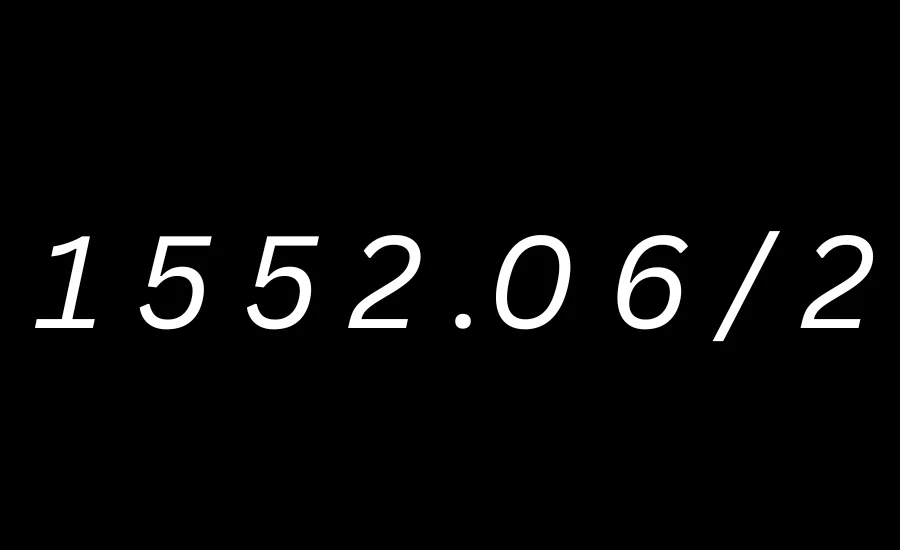1552.06/2: Exploring the Historical Significance and Turning Points in European History
The expression 1552.06/2 holds significant relevance across various academic disciplines, igniting interest and discussion among scholars and enthusiasts. This unique notation marks an essential moment in history, with implications that extend well into contemporary thought and research. Its significance goes beyond the mere numerical representation; it invites exploration into its historical background and the critical figures linked to it.
Understanding 1552.06/2 requires a deep dive into its historical context and the meanings that underpin it. This article will illuminate the various facets of this notation, shedding light on the events and ideas that have shaped its legacy. Furthermore, we will investigate how 1552.06/2 influences education and academia today, as well as its broader cultural and social implications. By examining these elements, readers will acquire a richer appreciation for this captivating subject and recognize its enduring impact on our understanding of history and culture.
Key Developments of 1552: Shaping Politics, Economy, and Religion

The year 1552 marked a pivotal period in History of Europe characterized by significant events that would resonate through subsequent centuries. On January 15, France entered into a covert treaty with German Protestants, indicating a transformative shift in alliances that altered the political landscape of the continent. This new partnership had a considerable impact on the power dynamics of the time, influencing events related to the notation 1552.06/2.
Another crucial development occurred on February 24, when England revoked the privileges of the Hanseatic League. This action had notable economic repercussions, disrupting trade relations and affecting commercial practices across Europe. The implications of this decision were felt throughout the continent, highlighting the interconnectedness of economic policies during this era.
In 1552, England’s religious landscape also saw substantial upheavals. On January 23, the acceptance of the second version of the Book of Common Prayer became required, firmly entrenching the Protestant Reformation within English culture. This change had a significant impact on the nation’s cultural and social fabric in addition to altering the religious practices of the time. When taken as a whole, these events highlight the intricate interactions between political, economic, and religious elements that shaped this exceptional year and added to the larger story of 1552’s history.06/2.
The Historical Significance of June 2, 1552, in European Context
The year 1552 represents a crucial chapter in European history, characterized by transformative events that significantly influenced the political and religious spheres of the time. The notation 1552.06/2 specifically denotes June 2, 1552, a date of notable importance in understanding the complexities of this era. This day serves as a marker within a broader historical narrative, reflecting the dynamic shifts and developments that were occurring across the continent. As various factions vied for power and influence, the implications of events around this date continue to resonate in discussions of Europe’s political and religious evolution.
The Strategic Significance of June 2, 1552: The Attack on Verdun
June 2, 1552, known in historical terms as 1552.06/2, stands out as a critical date in the landscape of European politics and military strategy. On this day, the land guardians of the Netherlands launched an offensive against Verdun, a pivotal move that significantly impacted the ongoing regional conflicts. This attack was part of a broader sequence of military actions and diplomatic negotiations that defined the tumultuous mid-16th century.
The assault on Verdun was emblematic of the intricate power dynamics and tensions that characterized Europe during this era. It underscored the complexities of alliances and rivalries, as various factions competed for dominance and influence. This event illustrates how military engagements were not merely isolated occurrences but integral components of the larger historical narrative, reflecting the persistent struggles for power that shaped the course of European history.
The Transformative Era of June 2, 1552: Political Shifts and Religious Reform
The political landscape surrounding June 2, 1552, was marked by rapidly changing alliances and persistent conflicts. A pivotal moment in this tumultuous year came with the signing of the Treaty of Passau on August 2, when Emperor Charles V officially recognized the Lutheran faith. This agreement signified a crucial shift in the religious and political dynamics within the Holy Roman Empire, fundamentally altering the relationship between Catholic and Protestant territories and reshaping the balance of power across Europe.
This period was also shaped by significant military actions from various rulers. For instance, on April 10, 1552, French King Henri II took control of Metz, adding further complexity to the geopolitical landscape. Such territorial conquests and military engagements were integral to the ongoing struggle for supremacy among European nations.
Moreover, the events of 1552 unfolded against a backdrop of notable economic expansion and societal change. The 16th century experienced robust economic growth, marked by population increases across much of Europe following centuries of decline and stagnation. This economic prosperity fueled a wide array of transformations—social, political, and cultural—that defined the early modern era.
Overall, the historical context surrounding June 2, 1552, reveals a continent in the midst of significant transition. Europe grappled with religious reformations, shifting political alliances, and economic advancements, all contributing to a dynamic and often turbulent environment that would influence the trajectory of European history for generations to come.
Navigating the Complexities of Historical Date Notation: The Case of 1552.06/2
The interpretation of historical dates can be quite intricate, particularly when considering the various dating systems employed throughout history. One notable example is the notation 1552.06/2, which, while clear in contemporary terms, could have been represented differently in its original context due to several variations in date notation.
Historically, the Julian Calendar was in use until the mid-18th century in England. Introduced by Julius Caesar in 45 B.C., this calendar gradually diverged from the actual solar year, leading to discrepancies in date alignment over time. Additionally, official records in the Early Modern period often relied on regnal years rather than standard calendar years. Documents might specify a date as “the 27th day of March in the first year of the reign of King Charles I,” emphasizing the importance of the reigning monarch.
The Christian Calendar, developed in A.D. 525, also influenced date notation, often using the names of holy days or feast days. For instance, September 29 might be referred to as Michaelmas instead of a numerical date. Furthermore, prior to the 16th century, the Roman numeral system (I, II, III, IV) was commonly employed for recording dates rather than Arabic numerals, which we use today.
During the Early Modern period, Latin played a significant role in documenting dates in English records, particularly in formal and legal documents. Moreover, the terms “Old Style” (O.S.) and “New Style” (N.S.) emerged following the Calendar Act, which transitioned the start of the year from March 25 to January 1 in England, further complicating the understanding of historical dates.
Additionally, it is crucial to recognize that in medieval Europe, the year was often calculated from March 25 (or occasionally from December 25) instead of January 1. As a result, a date such as 1552.06/2 could potentially refer to a different year, depending on the specific dating convention employed at that time.
For researchers and historians delving into pre-19th-century archival materials, grasping these nuances in date notation is essential. It demands a comprehensive understanding of historical dating systems and the ability to accurately convert between formats to ensure proper interpretation of significant events and timelines. Understanding these variations not only enriches our grasp of history but also underscores the importance of context when studying past events.
The Lasting Legacy of Influential Figures Around 1552.06/2: Raleigh Or Ricci And Rudolf II and Their Impact
The period around the date 1552.06/2 is noteworthy for the outstanding accomplishments of a number of significant personalities whose influence can still be felt today. Among them, Sir Walter Raleigh was crucial to the English colonization of North America, especially in starting the colony of Virginia. Raleigh made significant literary contributions to English literature, including prose and poetry, and his influence has endured. His account of his journey to modern-day Venezuela, The Discoverie of Guiana (1596), showcases his penchant for adventure as well as his literary prowess.
Another significant figure of this period is Matteo Ricci, whose impact on Sino-Western relations was transformative. By embracing Chinese language and culture, Ricci effectively integrated himself into Chinese society, fostering a mutual understanding that transcended religious boundaries. His contributions included introducing Western scientific knowledge and mathematics to China, exemplified by his work, The First Six Books of Euclid (1607), translated into Chinese. Ricci’s cartographic endeavors, notably his Great Map of Ten Thousand Countries, offered the Chinese intelligentsia an enriched perspective on global geography.
Rudolf II, the Holy Roman Emperor, also played a crucial role during this time, influencing European politics and culture significantly. His reign marked a flourishing of scientific and artistic pursuits in Prague, which became a vibrant hub attracting scholars and artists from various regions. Rudolf’s patronage of the arts and sciences catalyzed the Northern Renaissance, establishing Prague as a center of intellectual activity.
In addition to these figures, the period around 1552.06/2 saw the emergence of other notable personalities. Henry II of France, who became a Knight of the Garter under Edward VI of England in 1551, played an essential role in the intricate web of European politics. The Italian physician and mathematician Girolamo Cardano made groundbreaking advancements in mathematics and probability theory during this era, further contributing to the intellectual milieu of the time.
The convergence of these prominent individuals around the date 1552.06/2 highlights the historical significance of this period. Their diverse contributions to exploration, science, religion, and politics have not only shaped our understanding of the world but also continue to influence contemporary thought and practice. The legacy of Raleigh, Ricci, Rudolf II, and their contemporaries serves as a testament to the enduring impact of this dynamic era on subsequent centuries.
Read More: 127.0.0.1:49342
Societal and Economic Transformations Around 1552.06/2: A Period of Change in Europe

The timeframe surrounding 1552.06/2 was marked by significant societal changes and cultural developments that dramatically influenced Europe and its interactions with the wider world.Driven by technological advancements that changed trade routes and sparked cross-cultural interactions, this period marked a turning point in world history and changed the lives of formerly isolated populations.
Europe saw a significant demographic boom in the 16th century, with a population increase of more than 50% between 1500 and 1700. The flood of precious metals from the New World and this population boom set off an inflationary phase that lasted the entire century. The ensuing social and economic strains had a significant impact on day-to-day living.
One of the most critical societal shifts during this time was the decline in living standards for a substantial portion of the population. For many, particularly those outside the wealthiest class, nutritional quality deteriorated significantly compared to the late Middle Ages. Frequent illnesses and outbreaks of disease were exacerbated by a series of poor harvests, likely influenced by harsher winters experienced in the years following 1560.
The economic landscape of Europe also underwent considerable changes. Cities and towns faced diminished revenues as the demand for their manufactured goods waned. The authority of municipal guilds diminished, leading to a reduction in their influence over urban policy decisions. Artisans, particularly journeymen, found their prospects bleak, as the traditional pathway to mastery became increasingly elusive.
Agriculture during this period illustrated a growing divide within society. Rising grain prices and escalating land values benefited peasant proprietors to some extent; however, the most significant gains were realized by landowning nobles and wealthy urban patricians invested in agriculture. This led to a phenomenon referred to as a “second serfdom” in certain regions, where feudal lords imposed heavier labor and tax burdens on struggling smallholders.
Overall, the period surrounding 1552.06/2 marked a time of transformation that reshaped the socio-economic fabric of Europe. The interplay of demographic shifts, economic challenges, and evolving social structures set the stage for profound changes in the lives of ordinary people, ultimately influencing the trajectory of European history.
Final Words
The date 1552.06/2 stands as a pivotal moment in history, profoundly influencing various dimensions of the 16th century and its aftermath. This period was characterized by transformative shifts in the political landscape, significant religious reforms, and remarkable advancements in education and culture. The events that transpired around this date laid the groundwork for institutions and ideas that continue to resonate in our modern world.
The legacy of 1552.06/2 serves as a testament to the interconnectedness of historical developments and their enduring impact. Understanding this era not only enriches our comprehension of the past but also offers valuable insights into the challenges and opportunities we face today. By reflecting on this critical juncture in history, we can appreciate how the decisions and actions of those who lived during that time continue to shape our lives and influence our future.
As we examine the implications of 1552.06/2, we are reminded of the importance of historical context in informing our understanding of contemporary issues. The legacy of this date encourages us to explore the lessons learned from the past and consider how they can guide us in navigating the complexities of our present and future.
For More Information Check It Out Latest Drift






